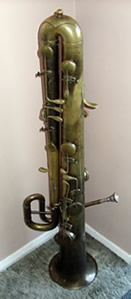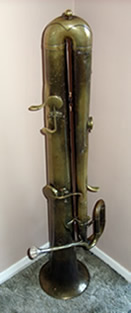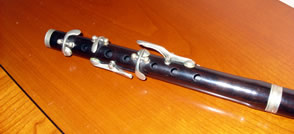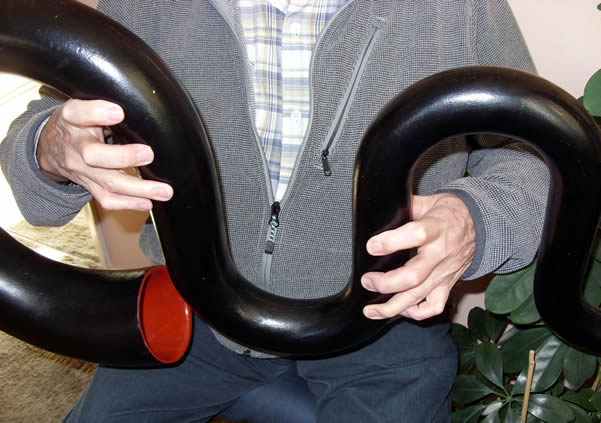Our InstrumentsThe instruments available to the church bands were relatively few in number, and reflected those used for the social and, to a lesser extent, the military music of the period. The clarinet, though quite a recent invention, was popular, and fiddles and flutes were around in plenty. The 'German Flute', as it was generally known, and the violin had previously been the instrument of the gentleman, played to the harpsichord or square piano accompaniment of a lady, but had now permeated society at almost all levels. These two instruments were associated with the social music of the period and were played by enough people to provide good availability for church bands. They were also popular with congregations, who associated them with happy social music. The bass line in West Gallery bands was provided by the serpent or bassoon, and later by instruments such as the cello (often referred to as a bass viol, an earlier bowed instrument) and a French development of the serpent in brass, called an ophicleïde. In the earlier period there may have been no more than a serpent supporting the bass line, an echo of its origins in France where it is said to have been invented by a priest in the sixteenth century to do just that. Returning soldiers and militiamen brought to the gallery bands their ophicleïdes (a brass instrument, the fusion of the serpent and bass horn) and keyed bugles. These were the bass and soprano instruments respectively of the serpent family. Military bands also provided the fife (a small, high-pitched, transverse flute) and the flageolet, once an orchestral instrument, and a descendant of the recorder, which had all but been forgotten in England by this time. The SerpentBedford Gallery Quire’s serpent is a resin copy of a French instrument, the original of which was carved from a fruitwood such as walnut. It is leather covered as most serpents seem to have been. It has a wooden mouthpiece (again a modern copy) which is inserted into a tapered brass tube which slides into the narrow end of the tube of the serpent. The level to which the brass tube is inserted governs tuning with, importantly, the assistance of the player’s lips. |
The OphicleïdeWe are very fortunate in having the long-term loan of the immediate historical descendent of the serpent, the ophicleïde, a French word derived partly from the Greek, meaning ‘keyed serpent’. The ophicleïde is essentially a military instrument, which may (with the flageolet) have come in to the church bands with the disbandment of militia regiments. In common with the serpent it has a mouthpiece like a brass instrument; our ophicleïde mouthpiece is a copy of an original from France of around 1820. The FlageoletAnother instrument with associations with military bands is the flageolet or flagelette. Bedford Gallery Quire uses a six-keyed instrument in African Blackwood, and a set of keyless flageolets in D, C, B flat, and G.
|
||||||
Serpent (playing position) link to more pictures |





